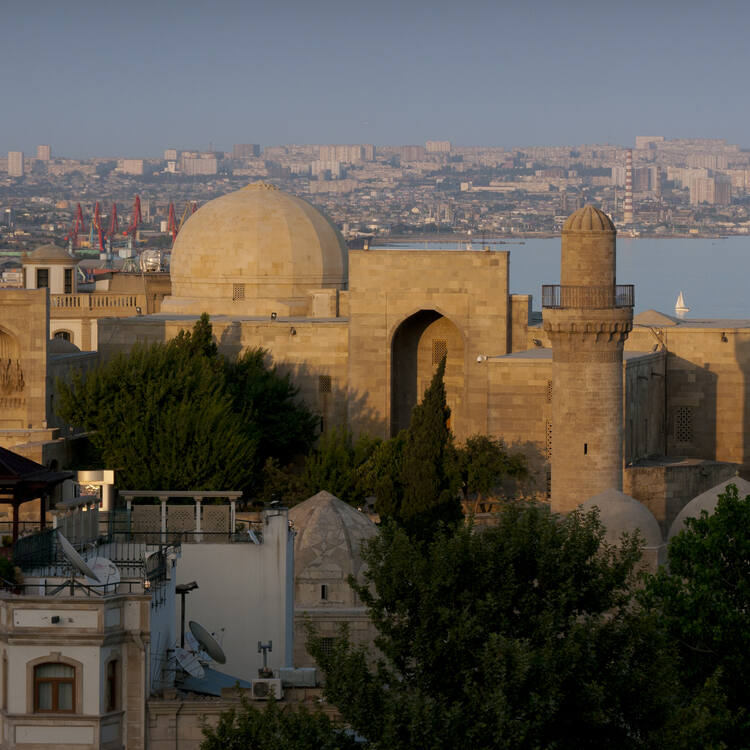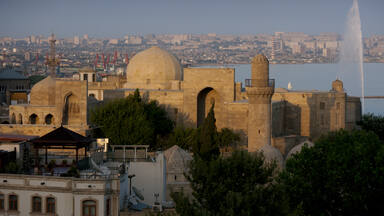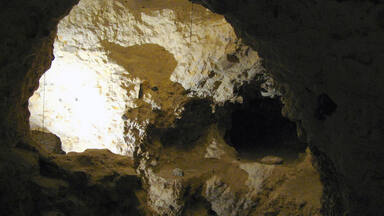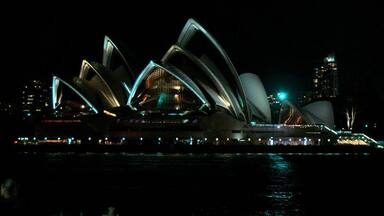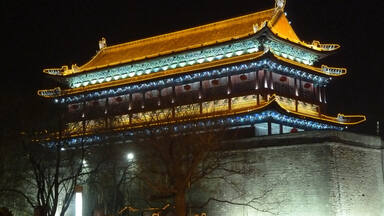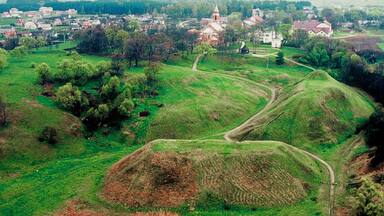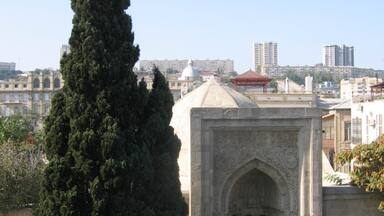Walled City of Baku with the Shirvanshah's Palace and Maiden Tower
Walled City of Baku with the Shirvanshah's Palace and Maiden Tower
Built on a site inhabited since the Palaeolithic period, the Walled City of Baku reveals evidence of Zoroastrian, Sasanian, Arabic, Persian, Shirvani, Ottoman, and Russian presence in cultural continuity. The Inner City (Icheri Sheher) has preserved much of its 12th-century defensive walls. The 12th-century Maiden Tower (Giz Galasy) is built over earlier structures dating from the 7th to 6th centuries BC, and the 15th-century Shirvanshahs' Palace is one of the pearls of Azerbaijan's architecture.
Description is available under license CC-BY-SA IGO 3.0
Cité fortifiée de Bakou avec le palais des Chahs de Chirvan et la tour de la Vierge
Édifiée sur un site habité depuis l'ère paléolithique, la cité fortifiée de Bakou incarne une remarquable continuité culturelle avec des traces de présence zoroastrienne, sassanide, arabe, perse, shirvani, ottomane et russe. La ville intra-muros (Icheri Sheher) a conservé une grande partie de ses remparts du XIIe siècle. La Tour de la Vierge (Giz Galasy), dont les structures d’origine remontent aux VIIe-VIe siècles avant notre ère, a été restaurée au XIIe siècle. Le Palais des Chahs de Chirvan, du XVe siècle, est un autre chef-d'œuvre de l'architecture azerbaïdjanaise.
Description is available under license CC-BY-SA IGO 3.0
مدينة باكو المحصنة مع قصر الشرفنشاهات وقلعة العذراء
شُيّدت القلعة على موقع مسكون منذ العصر الباليوليتي وهي تجسّد استمرارية ثقافية مميّزة بآثار الوجود الزا رادشتي والساساني والعربي والفارسي والشاروني والعثماني والروسي فيها. وقد حافظت المدينة داخل الاسوار (إشاري شيهر) على قسم كبير من جدرانها التي تعود إلى القرن الثاني عشر. أما برج العذراء (غيز غالاسي) والذي تعود هياكله الأصلية إلى القرنين السابع والسادس قبل الميلاد، فقد تمّ ترميمه في القرن الثاني عشر. ويبقى قصر الشرفنشاهات الذي شيّد في القرن الخامس عشر تحفة فنيّة أخرى من الهندسة الأذربيجانية.
source: UNESCO/CPE
Description is available under license CC-BY-SA IGO 3.0
城墙围绕的巴库城及其希尔凡王宫和少女塔
巴库城(Baku)的所在地自旧石器时代开始就有人类在此居住。巴库城集中展示了各个民族在当地文化的延续性,包括拜火教徒 (Zoroastrian)、萨桑王朝(Sasanian)、阿拉伯人、波斯人、希尔凡(Shirvani)、土耳其人和俄罗斯人。巴库内城保存了大量12世纪的防御墙。而同样在12世纪,当地人在一处公元前7世纪到公元前6世纪的建筑遗址之上建造了少女塔。建于15世纪的希尔凡王宫堪称阿塞拜疆建筑史上的一颗璀璨明珠。
source: UNESCO/CPE
Description is available under license CC-BY-SA IGO 3.0
Старая крепость в Баку с Дворцом ширваншахов и Девичьей Башней
Возведенная на обитаемой со времен палеолита местности, Старая крепость Баку сохранила черты разных культур, под влиянием которых она находилась на протяжении своей многовековой истории: зороастрийцев, Сасанидов, арабов, персов, ширванцев, турок и русских. Внутренний город – Ичери-Шехер – сохранил большую часть окружающей его крепостной стены XII в. В основании Девичьей Башни (Кыз-каласы), также построенной в XII в., обнаружены следы более ранних сооружений, относящихся к VII-VI вв. до н.э. Одной из жемчужин азербайджанской архитектуры является Дворец ширваншахов XV в.
source: UNESCO/CPE
Description is available under license CC-BY-SA IGO 3.0
Ciudad amurallada de Bakú, palacio de los sahs de Shirvan y Torre de la Doncella
Construida en un territorio habitado desde el Paleolítico, la ciudad amurallada de Bakú muestra las huellas de la presencia sucesiva de las culturas zoroástrica, sasánida, árabe, persa, shirvani, otomana y rusa. La parte intramuros (Icheri Shesher) ha conservado intacta una gran parte de sus murallas del siglo XII. La Torre de la Doncella (Giz Galasy) se erigió en ese mismo siglo sobre construcciones antiguas que datan de los siglos VII a VI a.C. El Palacio de los sahs de Shirvan (siglo XV) está considerado como una de las joyas de la arquitectura azerbaiyana.
source: UNESCO/CPE
Description is available under license CC-BY-SA IGO 3.0
城壁都市バクー、シルヴァンシャー宮殿、及び乙女の塔
source: NFUAJ
Ommuurde Stad van Bakoe met Shirvanshahpaleis en Maagdentoren
Source: unesco.nl
Outstanding Universal Value
Brief synthesis
Rising from the south shore of the Apsheron Peninsular at the western edge of the Caspian Sea, the Walled City of Baku was founded on a site inhabited since the Palaeolithic period. The city reveals, along with the dominant Azerbaijani element, evidence of Zoroastrian, Sassanian, Arabic, Persian, Shirvani, Ottoman, and Russian presence in cultural continuity. The inner city (Icherisheher) has preserved much of its 12th-century defensive walls, which define the character of the property. The most ancient monument of Icherisheher is the Maiden Tower – symbol of the city of Baku. Some evidence suggests that the construction of the Tower might have been as early as the 7th-6th centuries BC. Another monument of universal value, one of the pearls of Azerbaijan's architecture is the 12th- to 15th-century Shirvanshahs' Palace, located at the highest point of Icherisheher. Within the Palace complex are the Divankhana (reception hall) or, as some researchers believe, the Tomb of Shah, the residential building of Shirvanshahs, the remains of Key-Kubad Mosque, the Tomb of Seyid Yahya Bakuvi, Murad’s Gate (the only monument of the 16th century), the Tomb of Shirvanshahs’ Family, the Shah Mosque and the Palace bath-house. Earlier monuments of Icherisheher include the Mohammed Mosque, together with the adjacent minaret built in 1078, and remains of the 9th- to 10th-century mosque near the Maiden Tower.
There are also numerous historical-architectural monuments of the medieval period such as caravanserais, hamams (bath-houses), mosques and residential buildings of the 18th to 20th centuries located within the property.
The magnificence of Icherisheher lies in the combination of its distinct architectural monuments and its historically composed architectural spatial planning with original street views, which have merged into a single entity to reflect its long history and the melding of cultures that have influenced its development over the past nine centuries. Icherisheher is still a living, vibrant city with residential areas housing local communities.
Criterion (iv): The Walled City of Baku represents an outstanding and rare example of an historic urban ensemble and architecture with influence from Zoroastrian, Sassanian, Arabic, Persian, Shirvani, Ottoman, and Russian cultures.
Integrity
The boundary of the property follows the boundary of the Walled City, which with the remains of its walls, planning and buildings encompasses the attributes that express its Outstanding Universal Value.
Considerable erosion of the fabric of some of the buildings within the Walled City occurred soon after inscription of the property, partly as a result of an earthquake but also due to illegal demolition and uncontrolled development. The property was removed from the List of World Heritage in Danger in 2009.
The setting of the property has changed somewhat since inscription, due to building development that accompanied the disintegration of the previous Soviet management system and is still vulnerable to negative visual impacts of adjacent new development. The new management structure effectively combines municipal functions as well as property conservation functions.
Authenticity
Following inscription, the demolition and complete reconstruction of some buildings impacted adversely the authenticity of the overall urban ensemble. As a result of measures taken to enable removal of the property from the List of World Heritage in Danger, the remaining attributes can be said to convey the property’s Outstanding Universal Value in terms of materials, design and urban planning. The coherence and functions of the historic city are supported by a vibrant local community.
Protection and managements requirements
The Walled City of Baku and its buffer zone are inventoried and protected as National Monuments. The inner city is protected by Presidential Decrees of 2005 and 2007, and the buffer zone is protected by a Decree issued by the Cabinet of Ministers.
In 2007, the Administration of the State Historical-Architectural Reserve “Icherisheher” (SHAHAR), established under the Cabinet of Ministers, was formally given full responsibility for management of the property instead of the authorities of the Ministry of Culture and Tourism and the City of Baku. SHAHAR is independently staffed and funded by the Government. An Integrated Area Management Action Plan (IAMAP) has been developed, together with a Conservation Master Plan.
The Conservation Master Plan has been reviewed by all stakeholders and formally approved, and will be integrated with the IAMAP and adopted in the urban planning system of the City of Baku. The actions in the IAMAP will be implemented, including preparation of a comprehensive long-term strategy for the protection of Icherisheher and its buffer zone; documentation and monitoring of the state of conservation of the property; formulation of standards and procedures for the regulation of rehabilitation of existing buildings and eventual new constructions; maintenance and improvement of public spaces; development of strategic interventions to improve the quality of life in the area; and organisation and management of community outreach and education programmes.
There is a need to ensure that planning controls respect the characteristics of the modest houses that contribute to the overall qualities of Baku as a reflection of a medieval city. Numerous parts of the property retain original medieval street views and attention must be paid to preserve such views where they exist. Controls on development of the wider setting of the city is also needed so as to ensure it retains its links with the sea and does not become a small island within high-rise developments.
Links
-
Icherisheher Tiktok (only in Azerbaijani)
-
Icherisheher LinkedIn (only in Azerbaijani)
-
Icherisheher Twitter (only in Azerbaijani)
-
Icherisheher Youtube page (only in Azerbaijani)
-
Icherisheher Instagram (only in Azerbaijani)
-
Icherisheher Facebook (only in Azerbaijani)
-
Icherisheher Official Website
-
Azerbaijan Tourism Board
-
Google Arts & Culture: Story
-
Gobustan National Historical-Artistic Preserve
-
Administration of State Historical-Architectural Reserve "Icherisheher"
-
 View photos from OUR PLACE the World Heritage collection
View photos from OUR PLACE the World Heritage collection
